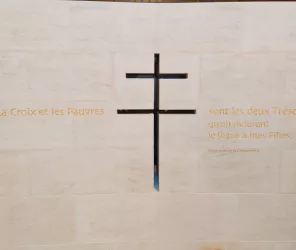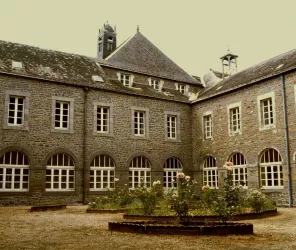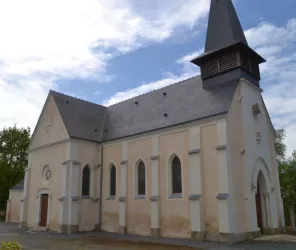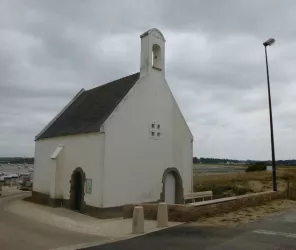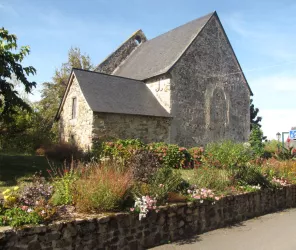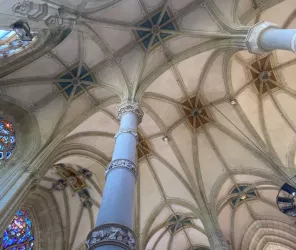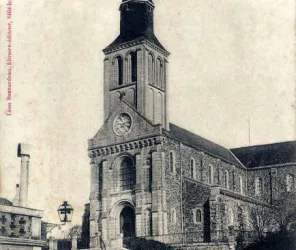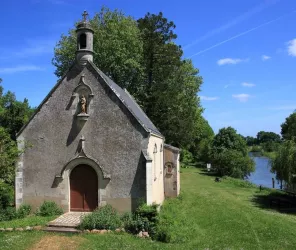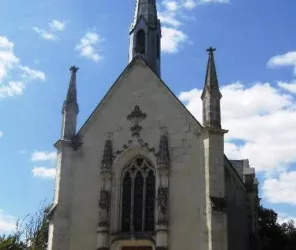L'église Saint-Pierre
In the market town of Les Moutiers, around a charming square steeped in history, stands the church of Saint-Pierre. It boasts one of the finest treasures in the Pays de Retz: its altarpiece.
Part of the building dates back to the 11th century and has the same architectural features: sloping buttresses and round-headed windows. A second part was built later, in the middle of the 16th century. The nave is framed like an overturned ship; unfortunately invisible, it was covered with panelling in 1827.The large 17th-century altarpiece (listed) occupies the entire chevet and surmounts three altars leaning against the gable. Six Corinthian columns support the full Greek entablature. The side niches house statues of the Virgin Mother and Pope Saint Clement.
The three-masted ship hanging at the back of the church is an ex-voto for sailors in distress. It is a reminder that Les Moutiers was once a seafarers' parish and that the sea reached the village.
In more detail...
The bell tower, a "fine point of onion mounted with seeds", has only existed since 1853; it is framed by 4 bell towers reminiscent of the Lantern of the Dead.
The bell tower was designed by the architect Renou, from Pornic.
From the ground to the top of the cross, it measures 45 metres and was built in 1853, under the pastorate of Abbé Maillard (who governed the parish from 1848 to 1878).
It replaces a square tower, which on today's sacristy was no higher than the ridge of the church.
There are 4 bells in the upper chamber. The oldest dates from 1840, the others from 1848.
The oldest part of the parish church, the men's monastery, dates from the 11th century.
From the outside, the church is a massive structure topped by an elegant bell tower with a choir.
The church is flanked by 12 squat buttresses. The two that continue the eastern gable have been placed at an angle in accordance with 11th century architecture.
The church's greatest treasure is its listed altarpiece. It is the work of Jean Boffrand and dates from the 17th century.
Six Corinthian columns support the entablature with architrave, frieze and cornice.
Above, the architect placed 3 niches flanked by light pilasters and scrolled brackets with flower vases and flamboyant urns.
The middle niche: 3 hearts flanked by 4 angels represent the Trinity.
The side niches house statues of the Virgin Mother and Pope Saint Clement.
The paintings in the choir, from left to right :
The Virgin gives the rosary to Saint Dominic, while the Child God gives it to Saint Catherine of Siena. Around the scene, the fifteen mysteries of the rosary unfold. This 1631 painting (Mannerist period) does not reveal the name of its author.
The central painting (restored at the end of the 19th century) is a good copy of one of the master's works. It depicts the "giving of the keys to Saint Peter".
Saint Clement, Pope, adorns the altar on the right, donated to the Church in 1631.
The statue of Saint Paul is in wood, while the statue of Saint Peter is in tufa stone. The scallop shells on the halo are a reminder of the pilgrimages to Compostela.
Above the door to the sacristy: a painting by the Florentine school depicts a "Virgin with a swaddled baby".
It was restored at the request of Abbé Coeslier and placed in the church under the title "NOTRE DAME DE PRIGNY".
The altars outside the choir date from the 18th century. They are surmounted by beautiful altarpieces with niches, garlands, potiches, columns, cartouches and a central painting. Despite their real interest, these altars are not listed.
The stained glass windows (the work of the Nantes master stained glass artist Uzureau) date from 1945. They depict evangelical scenes that are easy to interpret.
The ex-voto: model of a three-masted ship
This ex-voto represents a polychrome wooden trading boat measuring 2.37 m in length and 1.72 m in height. It bears witness to the maritime past of Moutiers-en-Retz and the neighbouring commune of La Bernerie-en-Retz.
From the 19th century until the 1960s, the model was lowered for the Assumption feast on 15 August and could be admired by parishioners and tourists during the night procession along the beach, which ended with the blessing of the sea.
A few figures for enthusiasts:
The surface area of the church: 370m² - it can hold 450 people
Central height: 14 metres
The benches date from 1867
The choir tiles date from 1775
The nave tiles, in Vigneux granite, date from 1867
The Stations of the Cross, painted on canvas, dates from 1875
Oriented towards the east according to liturgical traditions, Saint-Pierre church, to the west, has two doors and two windows: "Judicaël" and "Adénor", founders of the Ronceray Benedictine convent.
To the north, there are five windows and two doors: one, the "Sablais" door, is hidden inside by the polyphone; the other, the "Berneriens" door (or umbrella door, or broom door) has an awning. This is where the ladies used to redo their hairstyles, which had been tormented by the inclemency of the seasons, when they arrived at services on foot.
There was only one opening to the south, because of the sea wind and storms.
The little extras :
You can take an interest in this religious heritage of the commune by following the guided walking tour of Moutiers-en-Retz, a market town with ancestral origins.
The Saint-Pierre church can also be explored on the countryside walking trail.
Contact
Place de l'Eglise Madame
44760 LES MOUTIERS-EN-RETZ
FRANCE
44760 LES MOUTIERS-EN-RETZ
FRANCE
Practical information
Site theme
Church
Location
Further information
Pets not allowed





